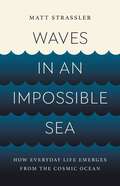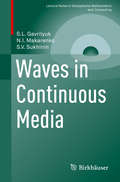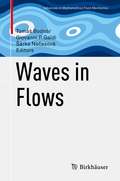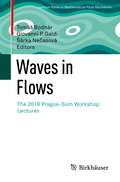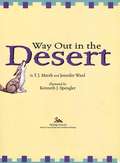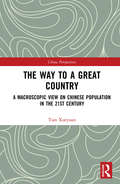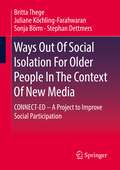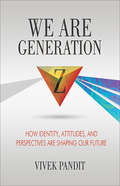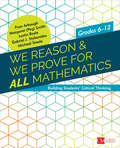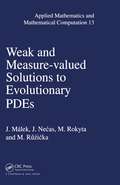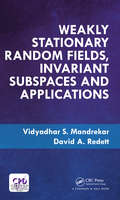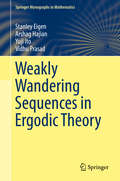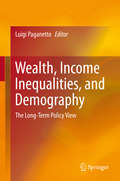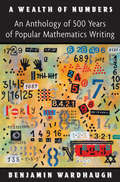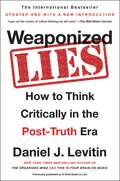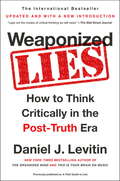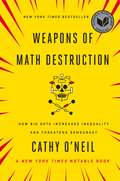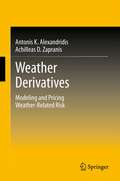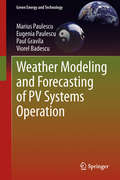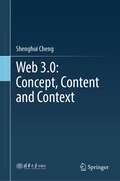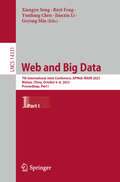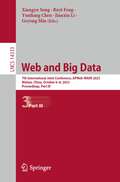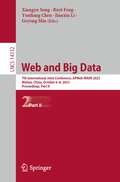- Table View
- List View
Waves in an Impossible Sea: How Everyday Life Emerges from the Cosmic Ocean
by Matt StrasslerA theoretical physicist takes readers on an awe-inspiring journey—found in "no other book" (Science)—to discover how the universe generates everything from nothing at all: "If you want to know what's really going on in the realms of relativity and particle physics, read this book" (Sean Carroll, author of The Biggest Ideas in the Universe). In Waves in an Impossible Sea, physicist Matt Strassler tells a startling tale of elementary particles, human experience, and empty space. He begins with a simple mystery of motion. When we drive at highway speeds with the windows down, the wind beats against our faces. Yet our planet hurtles through the cosmos at 150 miles per second, and we feel nothing of it. How can our voyage be so tranquil when, as Einstein discovered, matter warps space, and space deflects matter? The answer, Strassler reveals, is that empty space is a sea, albeit a paradoxically strange one. Much like water and air, it ripples in various ways, and we ourselves, made from its ripples, can move through space as effortlessly as waves crossing an ocean. Deftly weaving together daily experience and fundamental physics—the musical universe, the enigmatic quantum, cosmic fields, and the Higgs boson—Strassler shows us how all things, familiar and unfamiliar, emerge from what seems like nothing at all. Accessible and profound, Waves in an Impossible Sea is the ultimate guide to our place in the universe.
Waves in Continuous Media (Lecture Notes in Geosystems Mathematics and Computing)
by S. L. Gavrilyuk N.I. Makarenko S.V. SukhininStarting with the basic notions and facts of the mathematical theory of waves illustrated by numerous examples, exercises, and methods of solving typical problems Chapters 1 & 2 show e.g. how to recognize the hyperbolicity property, find characteristics, Riemann invariants and conservation laws for quasilinear systems of equations, construct and analyze solutions with weak or strong discontinuities, and how to investigate equations with dispersion and to construct travelling wave solutions for models reducible to nonlinear evolution equations. Chapter 3 deals with surface and internal waves in an incompressible fluid. The efficiency of mathematical methods is demonstrated on a hierarchy of approximate submodels generated from the Euler equations of homogeneous and non-homogeneous fluids. The self-contained presentations of the material is complemented by 200+ problems of different level of difficulty, numerous illustrations, and bibliographical recommendations.
Waves in Flows (Advances in Mathematical Fluid Mechanics)
by Tomáš Bodnár Giovanni P. Galdi Šárka NečasováThis volume offers an overview of the area of waves in fluids and the role they play in the mathematical analysis and numerical simulation of fluid flows. Based on lectures given at the summer school “Waves in Flows”, held in Prague from August 27-31, 2018, chapters are written by renowned experts in their respective fields. Featuring an accessible and flexible presentation, readers will be motivated to broaden their perspectives on the interconnectedness of mathematics and physics. A wide range of topics are presented, working from mathematical modelling to environmental, biomedical, and industrial applications. Specific topics covered include:Equatorial wave–current interactionsWater–wave problemsGravity wave propagationFlow–acoustic interactions Waves in Flows will appeal to graduate students and researchers in both mathematics and physics. Because of the applications presented, it will also be of interest to engineers working on environmental and industrial issues.
Waves in Flows: The 2018 Prague-Sum Workshop Lectures (Advances in Mathematical Fluid Mechanics)
by Tomáš Bodnár Giovanni P. Galdi Šárka NečasováThis volume explores a range of recent advances in mathematical fluid mechanics, covering theoretical topics and numerical methods. Chapters are based on the lectures given at a workshop in the summer school Waves in Flows, held in Prague from August 27-31, 2018. A broad overview of cutting edge research is presented, with a focus on mathematical modeling and numerical simulations. Readers will find a thorough analysis of numerous state-of-the-art developments presented by leading experts in their respective fields. Specific topics covered include:ChemorepulsionCompressible Navier-Stokes systemsNewtonian fluidsFluid-structure interactions Waves in Flows: The 2018 Prague-Sum Workshop Lectures will appeal to post-doctoral students and scientists whose work involves fluid mechanics.
Way Out in the Desert
by T. J. Marsh Jennifer WardThis toe-tapping text will have you singing along with the lovable creatures of the desert in no time! Filled with vibrant illustrations of many of the charming plants and animals that call the Sonoran Desert home, Way Out in the Desert is a wonderful teaching tool that takes you on a trip down memory lane. If you remember singing Over in the Meadow as a child, now you can give your children their own memories of this timeless tune. So take a child on a trip where Way out in the desert having fun in the sun lived a mother horned toad and her little toady one...
The Way to a Great Country: A Macroscopic View on Chinese Population in the 21st Century (China Perspectives)
by Tian XueyuanPopulation is the most influential factor in social development and economic growth, especially in China. In this book, author Tian Xueyuan provides macro illustrations of the main issues confronting China’s population and development in the 21st century and advises on facing population development challenges to sustainable future development. This book explores issues such as the relation between the change of population and consumption, how the age of the working population affects economic structure and transition when above or below the Lewis turning point, the impact of population aging on growth speed and the pension system, how to remove the urban– rural dual structure, how to reform exam- oriented education, and how to balance relations between population, resource, environment, and sustainable growth. The discussions on population– consumption relations, labor– economy relations, urbanization and rural– urban relations, and beyond provide insightful judgment on and prospects for China’s future development. This book is helpful for international audiences to better understand China’s population and development challenges and strategies.
Ways Out Of Social Isolation For Older People In The Context Of New Media: CONNECT-ED – A Project to Improve Social Participation
by Britta Thege Juliane Köchling-Farahwaran Sonja Börm Stephan DettmersThe book introduces the concept of encounter CONNECT-ED from the practice of working with the elderly to impart media skills and presents empirical data on the social participation and quality of life of the participants. The research results show the potential of the Internet for older people and open up perspectives for gender- and age-sensitive advanced training opportunities.
We Are Generation Z: How Identity, Attitudes, and Perspectives Are Shaping Our Future
by Vivek PanditA young author shares an insider’s perspective on what it means to be Generation Z—and what Generation Z means for the world.Born at the turn of the millennium, the members of Generation Z are no strangers to today’s fast-paced, hyperconnected world. They were born in the Digital Age. They grew up online. Their identities, attitudes, and perspectives have all been uniquely integrated with technology. Now, as they stand at the brink of adulthood, it’s time for the world to discover: Who is Generation Z?Vivek Pandit understands firsthand what it means to be a digital native, and he has a unique view of the road ahead. By exploring the forces that have shaped him and his peers, he gives insight into how they may go on to shape the world.Winner of the Moonbeam Children’s Book Award Gold Medal in the Youth Author (under 18) category
We Just Averaged over Two Trillion Cross-Country Growth Regressions
by Eduardo Ley Mark F.J. SteelA report from the International Monetary Fund.
We Reason & We Prove for ALL Mathematics: Building Students’ Critical Thinking, Grades 6-12 (Corwin Mathematics Series)
by Michael Steele Gabriel J. Stylianides Fran Arbaugh Margaret Peg Smith Justin D. BoyleSharpen concrete teaching strategies that empower students to reason-and-prove What does reasoning-and-proving instruction look like and how can teachers support students’ capacity to reason-and-prove? Designed as a learning tool for mathematics teachers in grades 6-12, this book transcends all mathematical content areas with a variety of activities for teachers that include Solving and discussing high-level mathematical tasks Analyzing narrative cases that make the relationship between teaching and learning salient Examining and interpreting student work Modifying curriculum materials and evaluating learning environments to better support students to reason-and-prove No other book tackles reasoning-and-proving with such breath, depth, and practical applicability.
We Reason & We Prove for ALL Mathematics: Building Students’ Critical Thinking, Grades 6-12 (Corwin Mathematics Series)
by Michael Steele Gabriel J. Stylianides Fran Arbaugh Margaret Peg Smith Justin D. BoyleSharpen concrete teaching strategies that empower students to reason-and-prove What does reasoning-and-proving instruction look like and how can teachers support students’ capacity to reason-and-prove? Designed as a learning tool for mathematics teachers in grades 6-12, this book transcends all mathematical content areas with a variety of activities for teachers that include Solving and discussing high-level mathematical tasks Analyzing narrative cases that make the relationship between teaching and learning salient Examining and interpreting student work Modifying curriculum materials and evaluating learning environments to better support students to reason-and-prove No other book tackles reasoning-and-proving with such breath, depth, and practical applicability.
Weak and Measure-Valued Solutions to Evolutionary PDEs
by J. Necas J. Malek M. Rokyta M. RuzickaThis book provides a concise treatment of the theory of nonlinear evolutionary partial differential equations. It provides a rigorous analysis of non-Newtonian fluids, and outlines its results for applications in physics, biology, and mechanical engineering
Weakly Stationary Random Fields, Invariant Subspaces and Applications
by Vidyadhar S. Mandrekar David A. RedettThe first book to examine weakly stationary random fields and their connections with invariant subspaces (an area associated with functional analysis). It reviews current literature, presents central issues and most important results within the area. For advanced Ph.D. students, researchers, especially those conducting research on Gaussian theory.
Weakly Wandering Sequences in Ergodic Theory
by Stanley Eigen Arshag Hajian Yuji Ito Vidhu PrasadThe appearance of weakly wandering (ww) sets and sequences for ergodic transformations over half a century ago was an unexpected and surprising event. In time it was shown that ww and related sequences reflected significant and deep properties of ergodic transformations that preserve an infinite measure. This monograph studies in a systematic way the role of ww and related sequences in the classification of ergodic transformations preserving an infinite measure. Connections of these sequences to additive number theory and tilings of the integers are also discussed. The material presented is self-contained and accessible to graduate students. A basic knowledge of measure theory is adequate for the reader.
Wealth, Income Inequalities, and Demography
by Luigi PaganettoIn this book, leading experts take a long-term view of the trends and policies of most relevance in achieving the structural readjustment required by the current crisis, which for too long has been viewed merely as an economic recession. A wide variety of issues are addressed, including the implications of the massive movement of wealth from advanced countries to emerging ones and the increasing income inequality evident within many countries. Prospects for growth toward the mid-century and beyond are discussed, with consideration of lessons from the past and the impact of various constraints, including corruption. The policies and reforms required to restore economic dynamism within the EU and more generally, to foster the "Good Economy" are discussed, recognizing the need for measures to promote innovation, entrepreneurship, well-being and high levels of environmental performance. The book comprises a selection of contributions presented at the XXV Villa Mondragone International Economic Seminar. For the past quarter of a century, this seminar has brought together leading experts to engage in debates on pressing economic questions. This book, based on the most recent gathering, will be of interest to all who are concerned about the challenges to growth, well-being and social inclusion that will have to be confronted in the coming decades.
A Wealth of Numbers
by Benjamin WardhaughDespite what we may sometimes imagine, popular mathematics writing didn't begin with Martin Gardner. In fact, it has a rich tradition stretching back hundreds of years. This entertaining and enlightening anthology--the first of its kind--gathers nearly one hundred fascinating selections from the past 500 years of popular math writing, bringing to life a little-known side of math history. Ranging from the late fifteenth to the late twentieth century, and drawing from books, newspapers, magazines, and websites, A Wealth of Numbers includes recreational, classroom, and work mathematics; mathematical histories and biographies; accounts of higher mathematics; explanations of mathematical instruments; discussions of how math should be taught and learned; reflections on the place of math in the world; and math in fiction and humor. Featuring many tricks, games, problems, and puzzles, as well as much history and trivia, the selections include a sixteenth-century guide to making a horizontal sundial; "Newton for the Ladies" (1739); Leonhard Euler on the idea of velocity (1760); "Mathematical Toys" (1785); a poetic version of the rule of three (1792); "Lotteries and Mountebanks" (1801); Lewis Carroll on the game of logic (1887); "Maps and Mazes" (1892); "Einstein's Real Achievement" (1921); "Riddles in Mathematics" (1945); "New Math for Parents" (1966); and "PC Astronomy" (1997). Organized by thematic chapters, each selection is placed in context by a brief introduction. A unique window into the hidden history of popular mathematics, A Wealth of Numbers will provide many hours of fun and learning to anyone who loves popular mathematics and science.
Weaponized Lies: How to Think Critically in the Post-Truth Era
by Daniel J. LevitinPreviously Published as A Field Guide to Lies We're surrounded by fringe theories, fake news, and pseudo-facts. These lies are getting repeated. New York Times bestselling author Daniel Levitin shows how to disarm these socially devastating inventions and get the American mind back on track. Here are the fundamental lessons in critical thinking that we need to know and share now. Investigating numerical misinformation, Daniel Levitin shows how mishandled statistics and graphs can give a grossly distorted perspective and lead us to terrible decisions. Wordy arguments on the other hand can easily be persuasive as they drift away from the facts in an appealing yet misguided way. The steps we can take to better evaluate news, advertisements, and reports are clearly detailed. Ultimately, Levitin turns to what underlies our ability to determine if something is true or false: the scientific method. He grapples with the limits of what we can and cannot know. Case studies are offered to demonstrate the applications of logical thinking to quite varied settings, spanning courtroom testimony, medical decision making, magic, modern physics, and conspiracy theories. This urgently needed book enables us to avoid the extremes of passive gullibility and cynical rejection. As Levitin attests: Truth matters. A post-truth era is an era of willful irrationality, reversing all the great advances humankind has made. Euphemisms like "fringe theories," "extreme views," "alt truth," and even "fake news" can literally be dangerous. Let's call lies what they are and catch those making them in the act.
Weaponized Lies: How to Think Critically in the Post-Truth Era
by Daniel J. LevitinIt's raining fringe theories, fake news, and pseudo-facts. These lies are getting repeated. New York Times bestselling author Daniel Levitin shows how to disarm these socially devastating inventions and get the American mind back on track. Here are the fundamental lessons in critical thinking (previously published as A Field Guide to Lies) that we need to know and share now. Investigating numerical misinformation, Daniel Levitin shows how mishandled statistics and graphs can give a grossly distorted perspective and lead us to terrible decisions. Wordy arguments on the other hand can easily be persuasive as they drift away from the facts in an appealing yet misguided way. The steps we can take to better evaluate news, advertisements, and reports are clearly detailed. Ultimately, Levitin turns to what underlies our ability to determine if something is true or false: the scientific method. He grapples with the limits of what we can and cannot know. Case studies are offered to demonstrate the applications of logical thinking to quite varied settings, spanning courtroom testimony, medical decision making, magic, modern physics, and conspiracy theories.This urgently needed book enables us to avoid the extremes of passive gullibility and cynical rejection. As Levitin attests: Truth matters. A post-truth era is an era of willful irrationality, reversing all the great advances humankind has made. Euphemisms like "fringe theories," "extreme views," "alt truth," and even "fake news" can literally be dangerous. Let's call lies what they are and catch those making them in the act.
Weapons of Math Destruction: How Big Data Increases Inequality and Threatens Democracy
by Cathy O'NeilLonglisted for the National Book AwardNew York Times BestsellerA former Wall Street quant sounds an alarm on the mathematical models that pervade modern life — and threaten to rip apart our social fabricWe live in the age of the algorithm. Increasingly, the decisions that affect our lives—where we go to school, whether we get a car loan, how much we pay for health insurance—are being made not by humans, but by mathematical models. In theory, this should lead to greater fairness: Everyone is judged according to the same rules, and bias is eliminated.But as Cathy O’Neil reveals in this urgent and necessary book, the opposite is true. The models being used today are opaque, unregulated, and uncontestable, even when they’re wrong. Most troubling, they reinforce discrimination: If a poor student can’t get a loan because a lending model deems him too risky (by virtue of his zip code), he’s then cut off from the kind of education that could pull him out of poverty, and a vicious spiral ensues. Models are propping up the lucky and punishing the downtrodden, creating a “toxic cocktail for democracy.” Welcome to the dark side of Big Data.Tracing the arc of a person’s life, O’Neil exposes the black box models that shape our future, both as individuals and as a society. These “weapons of math destruction” score teachers and students, sort résumés, grant (or deny) loans, evaluate workers, target voters, set parole, and monitor our health.O’Neil calls on modelers to take more responsibility for their algorithms and on policy makers to regulate their use. But in the end, it’s up to us to become more savvy about the models that govern our lives. This important book empowers us to ask the tough questions, uncover the truth, and demand change.— Longlist for National Book Award (Non-Fiction)— Goodreads, semi-finalist for the 2016 Goodreads Choice Awards (Science and Technology)— Kirkus, Best Books of 2016— New York Times, 100 Notable Books of 2016 (Non-Fiction)— The Guardian, Best Books of 2016— WBUR's "On Point," Best Books of 2016: Staff Picks— Boston Globe, Best Books of 2016, Non-Fiction
Weather Derivatives
by Achilleas D. Zapranis Antonis Alexandridis K.Weather derivatives are financial instruments that can be used by organizations or individuals as part of a risk management strategy to minimize risk associated with adverse or unexpected weather conditions. Just as traditional contingent claims, a weather derivative has an underlying measure, such as: rainfall, wind, snow or temperature. Nearly $1 trillion of the U.S. economy is directly exposed to weather-related risk. More precisely, almost 30% of the U.S. economy and 70% of U.S. companies are affected by weather. The purpose of this monograph is to conduct an in-depth analysis of financial products that are traded in the weather market. Presenting a pricing and modeling approach for weather derivatives written on various underlying weather variables will help students, researchers, and industry professionals accurately price weather derivatives, and will provide strategies for effectively hedging against weather-related risk. This book will link the mathematical aspects of the modeling procedure of weather variables to the financial markets and the pricing of weather derivatives. Very little has been published in the area of weather risk, and this volume will appeal to graduate-level students and researchers studying financial mathematics, risk management, or energy finance, in addition to investors and professionals within the financial services industry.
Weather Modeling and Forecasting of PV Systems Operation
by Viorel Badescu Eugenia Paulescu Paul Gravila Marius PaulescuIn the past decade, there has been a substantial increase of grid-feeding photovoltaic applications, thus raising the importance of solar electricity in the energy mix. This trend is expected to continue and may even increase. Apart from the high initial investment cost, the fluctuating nature of the solar resource raises particular insertion problems in electrical networks. Proper grid managing demands short- and long-time forecasting of solar power plant output. Weather modeling and forecasting of PV systems operation is focused on this issue. Models for predicting the state of the sky, nowcasting solar irradiance and forecasting solar irradiation are studied and exemplified. Statistical as well as artificial intelligence methods are described. The efficiency of photovoltaic converters is assessed for any weather conditions. Weather modeling and forecasting of PV systems operation is written for researchers, engineers, physicists and students interested in PV systems design and utilization.
Web 3.0: Concept, Content and Context
by Shenghui ChengAs technology continues to advance, the Internet is evolving into what is often referred to as Web 3.0. This book aims to achieve three main objectives, first, it introduces Web 3.0 systematically and comprehensively, providing readers with a foundational understanding of its concepts and characteristics. Second, it analyzes the inevitability and development necessity of Web 3.0, as well as its potential future possibilities and transformative effects. Finally, it explores Web 3.0 through comparative analysis, discussing its relationship with the metaverse as well as how individuals and organizations can seize the opportunities presented by Web 3.0. Various topics related to Web 3.0, including its infrastructure, development facilities, scenario applications, technology stacks, and industry applications such as decentralized applications (DApps) and Software-as-a-Service (SaaS) platforms are presented in the book. It delves into the ecosystem of Web 3.0, discussing decentralized autonomous organizations (DAOs), open finance (DeFi), cryptocurrencies, token economy, digital identity, creator economy, attention economy, and cyber-physical and human systems. Additionally, it addresses governance issues, security challenges, development challenges, and legal and regulatory aspects associated with Web 3.0. Overall, Web 3.0: Concept, Content and Context provides readers with a comprehensive understanding of Web 3.0, its potential implications, and the opportunities for new industry models and business opportunities in the evolving Internet era.
Web and Big Data: 7th International Joint Conference, APWeb-WAIM 2023, Wuhan, China, October 6–8, 2023, Proceedings, Part I (Lecture Notes in Computer Science #14331)
by Jianxin Li Geyong Min Xiangyu Song Ruyi Feng Yunliang ChenThe 4-volume set LNCS 14331, 14332, 14333, and 14334 constitutes the refereed proceedings of the 7th International Joint Conference, APWeb-WAIM 2023, which took place in Wuhan, China, in October 2023. The total of 138 papers included in the proceedings were carefully reviewed and selected from 434 submissions. They focus on innovative ideas, original research findings, case study results, and experienced insights in the areas of the World Wide Web and big data, covering Web technologies, database systems, information management, software engineering, knowledge graph, recommend system and big data.
Web and Big Data: 7th International Joint Conference, APWeb-WAIM 2023, Wuhan, China, October 6–8, 2023, Proceedings, Part III (Lecture Notes in Computer Science #14333)
by Jianxin Li Geyong Min Xiangyu Song Ruyi Feng Yunliang ChenThe 4-volume set LNCS 14331, 14332, 14333, and 14334 constitutes the refereed proceedings of the 7th International Joint Conference, APWeb-WAIM 2023, which took place in Wuhan, China, in October 2023. The total of 138 papers included in the proceedings were carefully reviewed and selected from 434 submissions. They focus on innovative ideas, original research findings, case study results, and experienced insights in the areas of the World Wide Web and big data, covering Web technologies, database systems, information management, software engineering, knowledge graph, recommend system and big data.
Web and Big Data: 7th International Joint Conference, APWeb-WAIM 2023, Wuhan, China, October 6–8, 2023, Proceedings, Part II (Lecture Notes in Computer Science #14332)
by Jianxin Li Geyong Min Xiangyu Song Ruyi Feng Yunliang ChenThe 4-volume set LNCS 14331, 14332, 14333, and 14334 constitutes the refereed proceedings of the 7th International Joint Conference, APWeb-WAIM 2023, which took place in Wuhan, China, in October 2023. The total of 138 papers included in the proceedings were carefully reviewed and selected from 434 submissions. They focus on innovative ideas, original research findings, case study results, and experienced insights in the areas of the World Wide Web and big data, covering Web technologies, database systems, information management, software engineering, knowledge graph, recommend system and big data.
